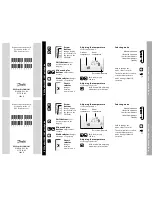
The electric fluid solenoid valve (3120-032) is installed in the hydraulic line as near to the point of dispensing
as possible (Figure 1, Item 11). One valve must be installed in the line of each outlet to be controlled. It is sug
-
gested that a manual by-pass valve be installed around the solenoid valve as shown in the diagram (Figure
1, Item 9). This allows the solenoid valve to be by-passed in case of electric power line failure. The by-pass
valve should allow for locking in either the open or closed position by means of a padlock or sealing wire to
avoid tampering.
ELECTRICAL
Refer to Figures 2 and 3 for electrical installation.
Installation should be made in accordance with the National Electrical Code (NFPA 70) and the Flammable
and Combustible Liquids Code (NFPA 30).
Power input to the Director Jr. is 110 VAC. All control circuits are 24 VDC which are not normally restricted by
electrical codes, however, local codes should be checked for applicability, and all electrical installations should
comply with codes.
Place the console(s) where it will normally be used. All electrical connections are made through the multi-wire
cable supplied with the unit. Some kind of pull box should be mounted within 5 feet of the console. A suitable
place might be behind a desk or in the ceiling where the existing electrical system is likely located. Connect
the supplied cable to a screw type terminal strip with 14 terminals that is mounted inside the box as indicated
in Figure 2.
No. 18 AWG wire is recommended for all runs less than 400 feet. For runs from 400 to 625 feet, use wire no.
16 AWG or larger. Normally the 24 VDC wiring can be run around the overhead structure of the building with-
out using conduit. This wire should be clamped or secured to the structure in such a way that it is not subject
to any mechanical stress. Use a strain relieving clamp any time a cable enters a junction box. The cables
from all the consoles in the system can be run to one junction box with conduit running to the 110 VAC circuit
breakers and then using multi-wire cable for the control circuit runs.
Another junction box should be installed within a few feet of the impulse meter (less than 10 feet). A control
cable can then be used to run between this box and the console junction box. Solderless connections (wire
nuts) can be used for the connections in this box.
Another junction box or group of boxes should be mounted near the solenoid valves. In the case of a reel
bank, one junction box may suffice for several valves. In the event that a number of reel banks or oil bars or
other dispensing points are used, it may be necessary to locate separate junctions boxes at each dispensing
location. The two wires from each electrical solenoid valve should be run inside of plastic or metal sheathing
for mechanical protection. In the event that the junction box is located at a distance from the valve greater
than the length of the valve wires, it may be necessary to splice two ends of the wires together, soldering
them and then covering the connection with heat shrinking tubing.
An optional extra to the system is a “Ready” light (3120-031). This light is installed within sight of the dispens
-
ing mechanic. It may be attached to the side of the reel bank, oil bar, or an adjacent wall. The wires of the
“Ready” light are run to the solenoid valve junction box and are wired in parallel with the valve.
6
Summary of Contents for Director Jr. 3110-031
Page 17: ...16 NOTES...




































